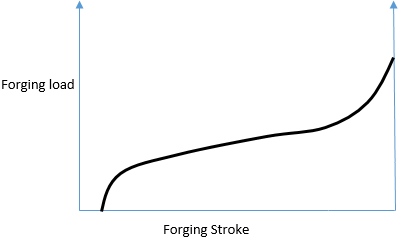This set of Mechanical Metallurgy Multiple Choice Questions & Answers (MCQs) focuses on “Forging in Plane Strain”.
1. The coining operation is a ___________ process.
a) piercing
b) cold forging
c) extrusion
d) drawing
View Answer
Explanation: The coining is the cold forging process in which the circular shaped disc is punched out of thick sheet metal. It is carried out a room temperature.
2. A sheet under plane strain compression test will have stress ___________ than the mean stress on the sheet.
a) higher
b) lower
c) equal
d) depends upon the material
View Answer
Explanation: The mean pressure on the sheet is 15.5 percent higher than it is in case of a uniaxial compression test.
-> σ=√3/2(p)
-> where σ uniaxial stress and p is plane strain condition strain.
3. In a multi-pass rolling operation, the temperature in the last pass is kept low. This is because it is associated with ___________
a) control of dimension
b) avoiding oxidation
c) grain size control
d) avoiding defects
View Answer
Explanation: The grain size increases with increase in the temperature of the material. Due to this, if high temperature is kept in the last pass, the grains will remains larger and elongated, so to avoid this temperature is kept low.
4. The crankshaft for the engine is made by which of the following process?
a) Casting
b) Rolling
c) Forging
d) Sheet metal forming
View Answer
Explanation: The crankshaft is always made with forging process. This will help in avoiding the direction abnormality associated with other means and provide superior strength.
5. The cold shut is associated with which of the following metal working process?
a) Forging
b) Deep drawing
c) Rolling
d) Extrusion
View Answer
Explanation: The cold shut is defect and associated with forging. In this, two stream of deforming metal joins together but do not fuse properly. The cold shut is dangerous for the metal in processing.
6. The rotor for the turbine is made by which of the following metal working process?
a) Forging
b) Deep drawing
c) Rolling
d) Extrusion
View Answer
Explanation: The rotor for a turbine for generally made by forging process. The rotor is made of copper or other high heat conductive material because it is made of single piece material.
7. The orange peel effect is the defect associated with which of the following metal working process?
a) Forging
b) Deep drawing
c) Rolling
d) Extrusion
View Answer
Explanation: The orange peel effect is defect in which the layer of the metal is peeled off from the surface because of larger grain size. As the large grain do not tend to bend, so on extrusion the peel is formed the surface.
8. Which of the following method is used to make a simple shape of material from billet?
a) Open die forging
b) Closed die forging
c) Press forging
d) Impact forging
View Answer
Explanation: The open die forging is relatively simple method in which the simple shapes can be easily made with relatively low cost and complexity. The slab from billet is made by this method.
9. Which of the following process is used to shape the end of dying into the desired shape?
a) Fullering
b) Drawing
c) Edging
d) Swaging
View Answer
Explanation: The edging is defined as the process in which the ends of the slab, rod or sheet are compressed between a closed die to force it to flow into the desired shape by restraining between the die.
10. The width of the channels of flash in closed die forging should be ______________
a) greater than the minimum thickness of the cavity
b) less than the minimum thickness of the cavity
c) greater than the maximum thickness of the cavity
d) lesser than the maximum thickness of the cavity
View Answer
Explanation: The purpose of the flash is to ensure that cavity is filled, then the material will flow to gutter flash. It this to provide the extra stress for filling of the cavity.
11. The next curve represents the correct relationship between the forging load and forging stroke/ completion of the process.

a) True
b) False
View Answer
Explanation: In closed die forging, the initial load required to cause the deformation is low, but with the increasing stroke the forging load also increases rapidly and then finally, to fill the last unfilled cavity to required pressure will be maximum.
12. The forging load required will ___________ with increase in the width of flash.
a) increase
b) decrease
c) remain the same
d) no relationship
View Answer
Explanation: The required load for forging keeps on decreasing with an increase in the width of the gutter flash channel. This is because the larger will be the cross-sectional area, easier it will be for the material to flow.
Sanfoundry Global Education & Learning Series – Mechanical Metallurgy.
To practice all areas of Mechanical Metallurgy, here is complete set of 1000+ Multiple Choice Questions and Answers.
If you find a mistake in question / option / answer, kindly take a screenshot and email to [email protected]
- Check Mechanical Metallurgy Books
- Apply for Metallurgical Engineering Internship
- Check Metallurgical Engineering Books
- Practice Metallurgical Engineering MCQs
